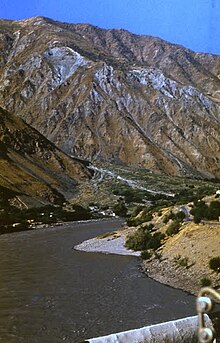Panj (river)
From there, it flows westwards, marking part of the border of Afghanistan and Tajikistan.After passing the city of Khorugh, capital of the Gorno-Badakhshan Autonomous Region of Tajikistan it receives water from one of its main tributaries, the Bartang River.A water treaty between the Soviet Union and Afghanistan, signed in 1946, allows Afghanistan to draw 9 million cubic metres of water a year from the Panj.According to the Panj River Basin Project, environmental damage could be expected if Afghanistan drew the entire amount of allocated water from the river under the treaty.The Aga Khan Development Network has been engaged in a project to build a series of three bridges across the Panj River between Tajikistan and Afghanistan.


PunjabAfghanistanTajikistanWakhan RiversAmu DaryaAral SeaRamsar WetlandtributaryAfghanistan–Tajikistan borderPamir RiverWakhan RiverQalʽeh-ye PanjehKhorughGorno-Badakhshan Autonomous RegionBartang Riverriver VakhshCentral AsiaSovietSoviet military operations in AfghanistanKevronSoviet UnionAfghanistan-Tajikistan BridgeNizhnii PanjbridgeRizzani de Eccher S.p.A.US Army Corps of EngineersGunt RiverKhorogLangarAga Khan Development NetworkDemoganEmomali RahmonovHedayat Amin ArsalaHis Highness the Aga KhanTajik-Afghan Friendship BridgeDarwazIshkashim, AfghanistanIshkashim, TajikistanExtreme points of AfghanistanRussianRamsarGreat Soviet EncyclopediaAsian Development BankAsia-PlusAk-SuuBartangFan DaryaIskander DaryaKaratagKhanakaKofarnihonKyzylsuShakhdaraSimiganjSyr DaryaVakhshYaghnobYazgulemZambarZeravshan